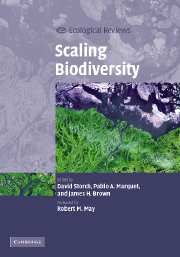Book contents
- Frontmatter
- Contents
- List of contributors
- Foreword by Robert M. May (Lord May of Oxford)
- Preface
- 1 Introduction: scaling biodiversity – what is the problem?
- PART I Spatial scaling of species richness and distribution
- PART II Alternative measures of biodiversity: taxonomy, phylogeny, and turnover
- PART III Scaling of biological diversity with energy and the latitudinal biodiversity gradient
- PART IV Processes, perspectives, and syntheses
- 16 Spatiotemporal scaling of species richness: patterns, processes, and implications
- 17 Scaling biodiversity under neutrality
- 18 General patterns in plant invasions: a family of quasi-neutral models
- 19 Extinction and population scaling
- 20 Survival of species in patchy landscapes: percolation in space and time
- 21 Biodiversity power laws
- Index
- Plate section
- References
16 - Spatiotemporal scaling of species richness: patterns, processes, and implications
Published online by Cambridge University Press: 05 August 2012
- Frontmatter
- Contents
- List of contributors
- Foreword by Robert M. May (Lord May of Oxford)
- Preface
- 1 Introduction: scaling biodiversity – what is the problem?
- PART I Spatial scaling of species richness and distribution
- PART II Alternative measures of biodiversity: taxonomy, phylogeny, and turnover
- PART III Scaling of biological diversity with energy and the latitudinal biodiversity gradient
- PART IV Processes, perspectives, and syntheses
- 16 Spatiotemporal scaling of species richness: patterns, processes, and implications
- 17 Scaling biodiversity under neutrality
- 18 General patterns in plant invasions: a family of quasi-neutral models
- 19 Extinction and population scaling
- 20 Survival of species in patchy landscapes: percolation in space and time
- 21 Biodiversity power laws
- Index
- Plate section
- References
Summary
The resemblance between time and space, in its simplest form, may be seen by driving a stake into the open water of a lake and then taking a transect toward the shore. We pass first through planktonic vegetation, then perhaps water lilies, then marsh, then grassland, then a succession of forest stages to climax forest. But we can pass through the same succession in the same order without moving at all. We may just sit by the stake for a few years or centuries and the seral stages will come to us one after the other as the lake fills in or drains.
Frank W. Preston (1960)Introduction
Understanding observed patterns of species diversity is a major focus of ecological research (e.g. Hutchinson, 1959; Brown, 1981; Gaston, 2000). However, it is increasingly well established that observed patterns and correlates of species richness are strongly dependent on the spatial scale of analysis (e.g. Levin, 1992; Wright, Currie & Maurer, 1993; Mittelbach et al., 2001; Rahbek & Graves, 2001). This dependence results from differences in how species richness changes with the area sampled (Scheiner et al., 2000; Chase & Leibold, 2002; Lyons & Willig, 2002).
There are literally hundreds of studies on the effects of spatial scale on species richness (the species–area relationship), and numerous additional studies on spatial species turnover (e.g. Connor & McCoy, 1979; Rosenzweig, 1995; Koleff, Gaston & Lennon, 2003).
- Type
- Chapter
- Information
- Scaling Biodiversity , pp. 325 - 346Publisher: Cambridge University PressPrint publication year: 2007
References
- 21
- Cited by

